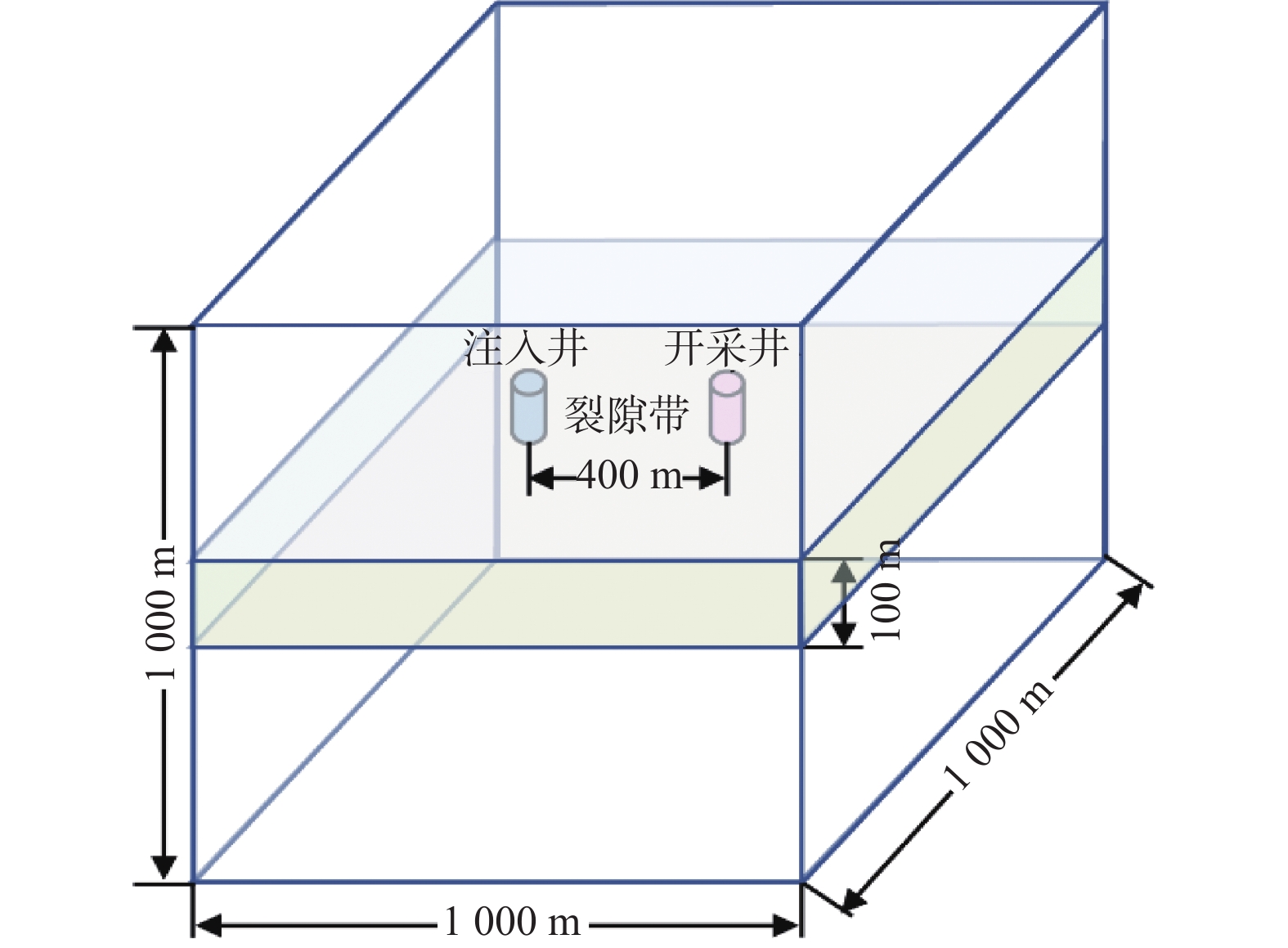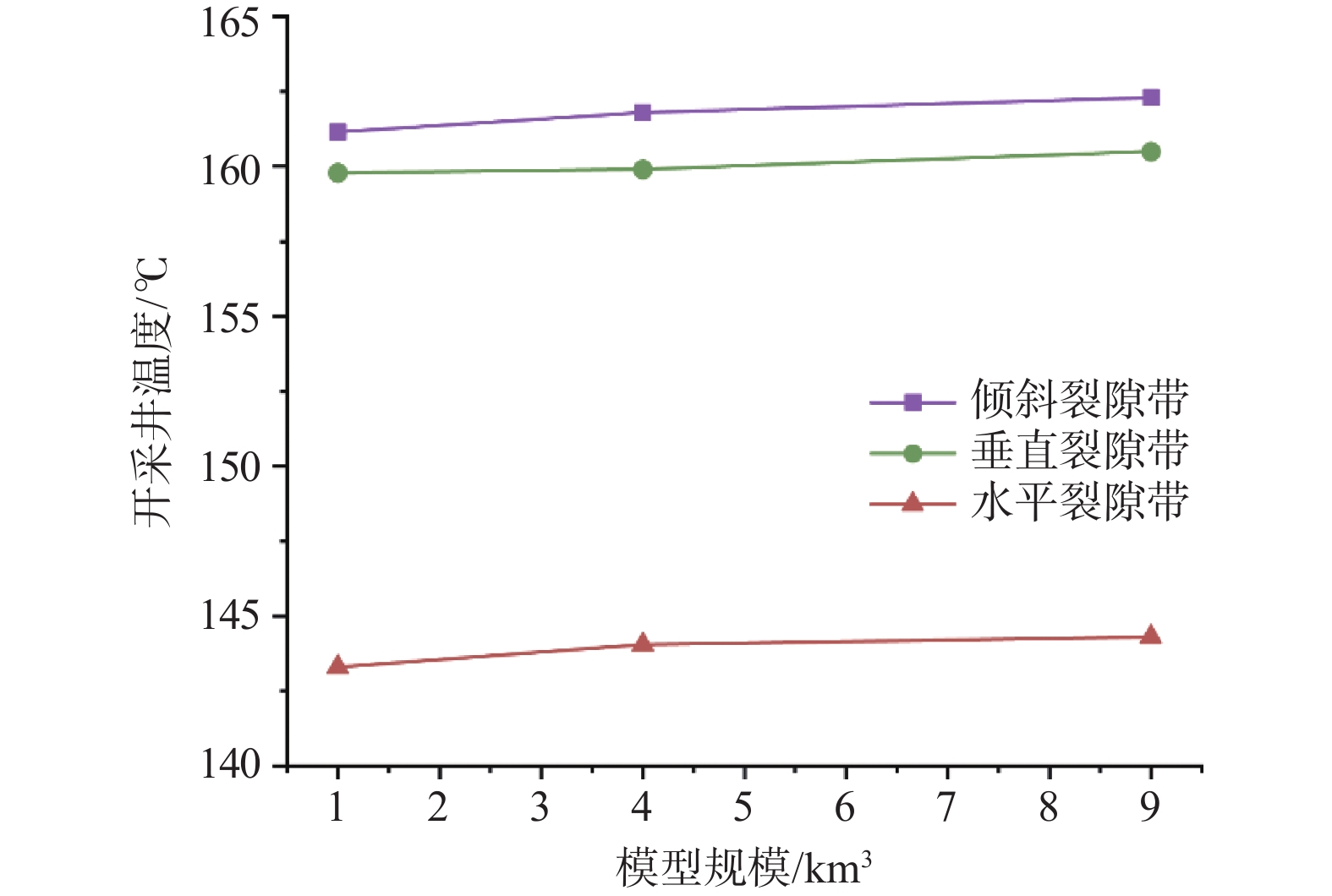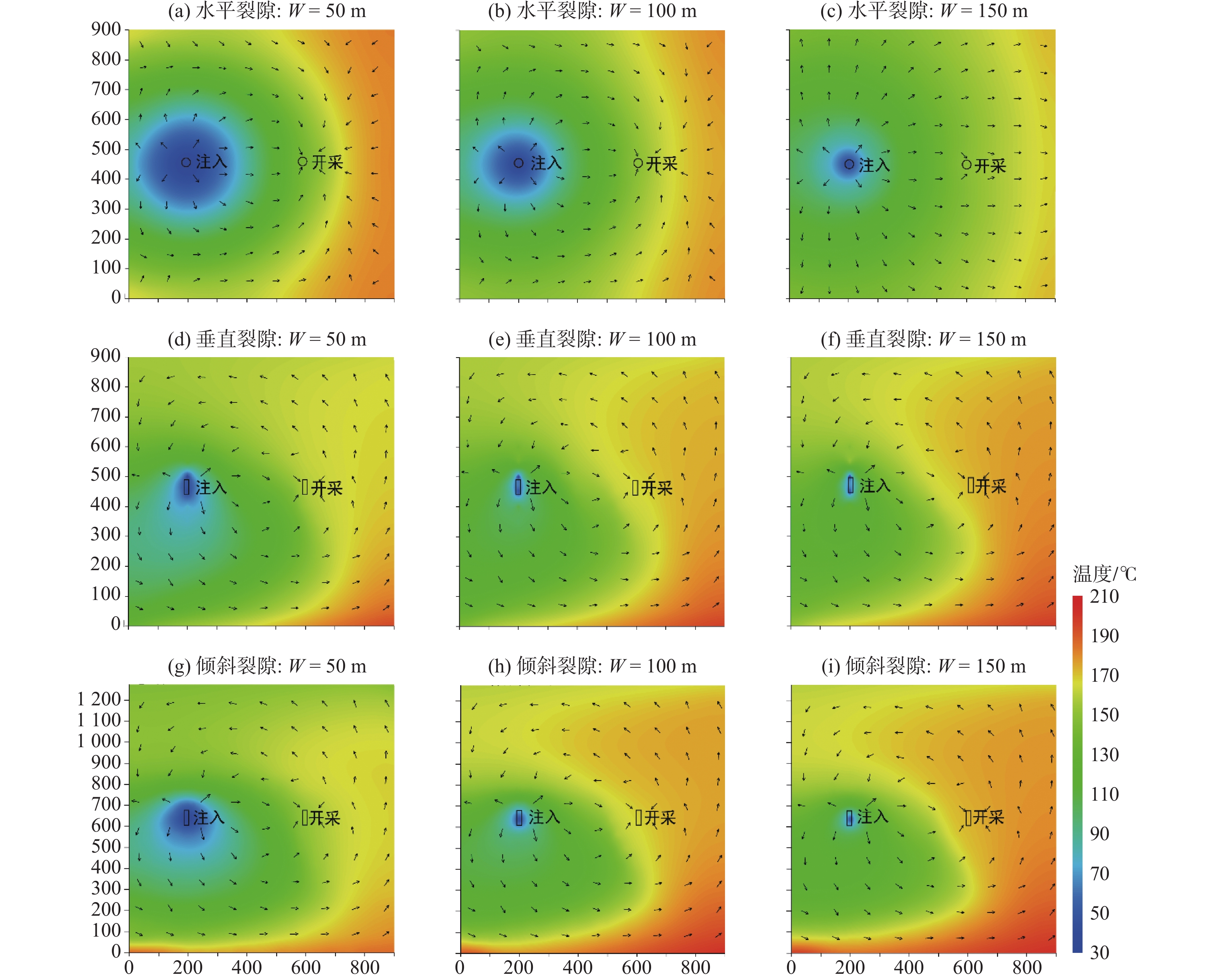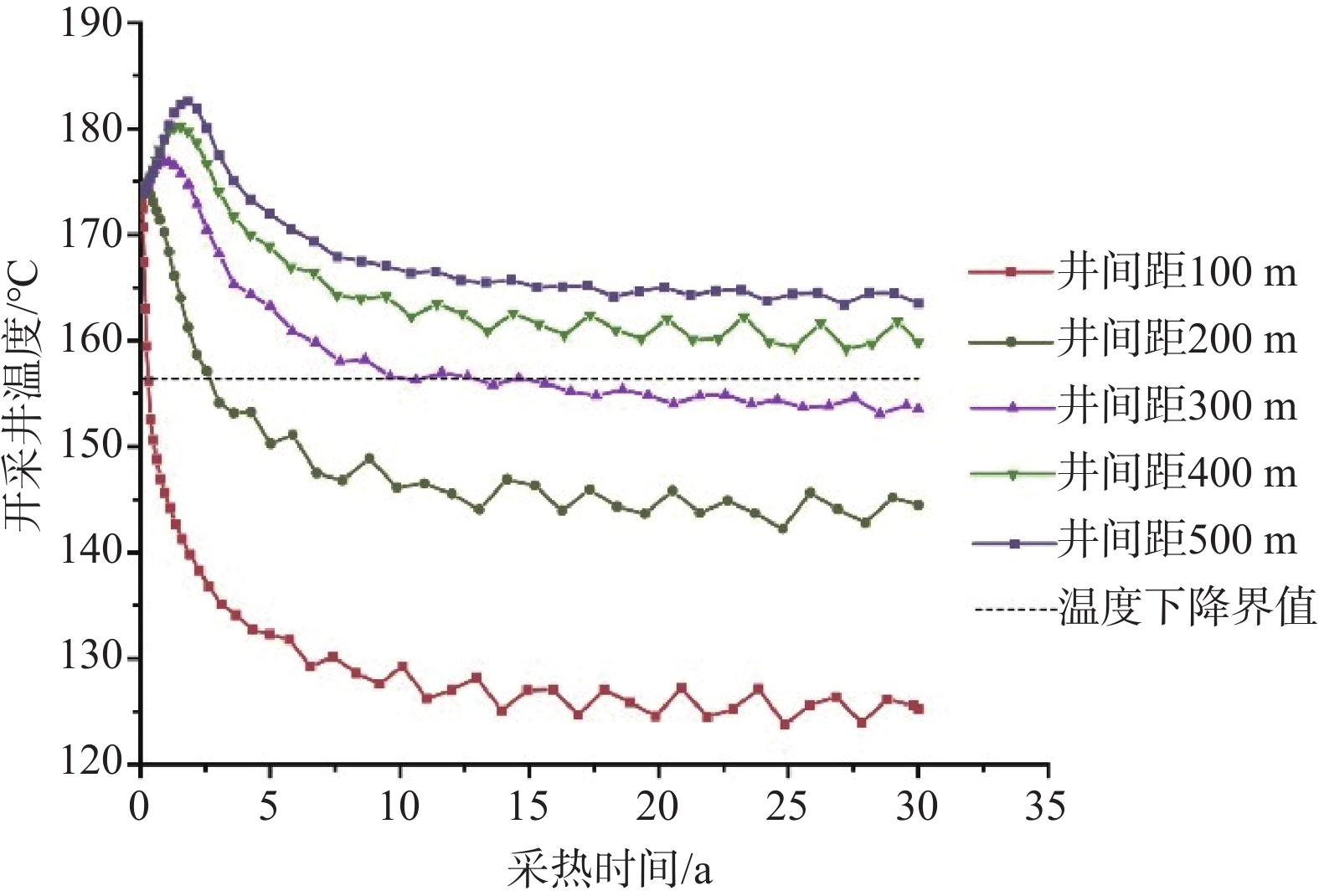Heat control mechanism and productivity optimization of artificial fracture zone structure of dry hot rock in Gonghe Basin
-
摘要:
人工压裂是获取干热岩型地热资源的关键环节,压裂后的人工裂隙带结构对开采条件下水热传递过程具有重要控制作用。结合我国共和盆地干热岩储层地质条件,采用数值模拟方法着重分析干热岩不同产状人工裂隙带的渗透率与宽度对热储中水热传递过程的影响机理,明确不同人工裂隙结构条件下水热产出能力,进而优化井间距。结果表明:当人工裂隙带渗透率较小时(小于5 D),裂隙带规模越大,开采井温度越高;当渗透率较大时(大于10 D),在水平裂隙带中,随着裂隙带规模的增加,由于注入冷水的快速扩散导致整体低温区域增加,开采井温度反而降低。在水平裂隙带中注入冷水主要为水平向流动,随着渗透率的增加,开采井温度更易受注入冷水的影响而降低;但在垂直裂隙带及倾斜裂隙带中,随着渗透率的增加,垂向自由对流增强,注入冷水更易于向储层底部高温区域流动,经加热后到达开采井,使得开采温度提升。综合比较,同一井间距条件下,低渗水平裂隙带以及高渗垂直裂隙带的产热能力较其他裂隙带更强。
Abstract:Hydraulic fracturing is necessary to obtain geothermal energy from the hot dry rocks. The structure of the artificial fractures plays an important role in controlling the water and heat transport during the heat production. In this study, we analyzed the influence of the permeability and width of artificial fracture zone on the coupled heat and flow processes in the Gonghe Basin, China. The results showed that in the fractured reservoir with permeability lower than 5 D, the outflow temperature increases with the width of the fracture zones. This is because the injected cold water can sufficiently merge with the thermal water in the reservoir, and has a weak influence on the water temperature close to the extraction well. A special situation occurs in the horizontal reservoir with permeability higher than 10 D, where the outflow temperature decreases with the increase of fracture zone width, because the overall low temperature zone is increased due to the rapid diffusion of injected cold water. In the reservoir with horizontal fracture zone, outflow temperature decreases with the increase of the permeability, because the injected cold water easily arrives the production well. In contrast, in the vertical or tilted fracture reservoir, the outflow temperature increases with the permeability, because the free convection occurs strongly in the high-permeable reservoirs. A synthetic comparison suggested that under the same well distance, heat production is higher in the reservoirs with low-permeable horizontal fracture zone and with high-permeable vertical fracture zone, among other fracture zones.
-

-
[1] 蔺文静, 刘志明, 马峰, 等. 我国陆区干热岩资源潜力估算[J]. 地球学报,2012,33(5):807 − 811. [LIN Wenjing, LIU Zhiming, MA Feng, et al. An estimation of HDR resources in China's mainland[J]. Acta Geoscientica Sinica,2012,33(5):807 − 811. (in Chinese with English abstract) doi: 10.3975/cagsb.2012.05.12
[2] TESTER J W, ANDERSON B J, BATCHELOR A S, et al. The future of geothermal energy impact of enhanced geothermal systems [EGS] on the United States in the 21st Century[R]. Boston: Massachusetts Institute of Technology, 2006.
[3] GÉRARD A, GENTER A, KOHL T, et al. The deep EGS (Enhanced Geothermal System) project at Soultz-sous-Forêts (Alsace, France)[J]. Geothermics,2006,35(5/6):473 − 483.
[4] 许天福, 张延军, 曾昭发, 等. 增强型地热系统(干热岩)开发技术进展[J]. 科技导报,2012,30(32):42 − 45. [XU Tianfu, ZHANG Yanjun, ZENG Zhaofa, et al. Technology progress in an enhanced geothermal system (hot dry rock)[J]. Science & Technology Review,2012,30(32):42 − 45. (in Chinese with English abstract) doi: 10.3981/j.issn.1000-7857.2012.32.004
[5] LUO S, ZHAO Z H, PENG H, et al. The role of fracture surface roughness in macroscopic fluid flow and heat transfer in fractured rocks[J]. International Journal of Rock Mechanics and Mining Sciences,2016,87:29 − 38. doi: 10.1016/j.ijrmms.2016.05.006
[6] HE R H, RONG G, TAN J, et al. Numerical investigation of fracture morphology effect on heat transfer characteristics of water flow through a single fracture[J]. Geothermics,2019,82:51 − 62. doi: 10.1016/j.geothermics.2019.05.014
[7] LI Z W, FENG X T, ZHANG Y J, et al. Experimental research on the convection heat transfer characteristics of distilled water in manmade smooth and rough rock fractures[J]. Energy,2017,133:206 − 218. doi: 10.1016/j.energy.2017.05.127
[8] JIANG Z J, XU T F, WANG Y. Enhancing heat production by managing heat and water flow in confined geothermal aquifers[J]. Renewable Energy,2019,142:684 − 694. doi: 10.1016/j.renene.2019.03.147
[9] PASHKEVICH R I, TASKIN V V. Numerical simulation of exploitation of supercritical enhanced geothermal system[R]. California: Proceedings of Thirty-fourth Workshop on Geothermal Reservoir Engineering, 2009.
[10] 陈继良, 蒋方明. 增强型地热系统热开采性能的数值模拟分析[J]. 可再生能源,2013,31(12):111 − 117. [CHEN Jiliang, JIANG Fangming. A numerical study on heat extraction performance of enhanced geothermal systems[J]. Renewable Energy Resources,2013,31(12):111 − 117. (in Chinese with English abstract) doi: 10.3969/j.issn.1671-5292.2013.12.024
[11] 雷宏武, 金光荣, 李佳琦, 等. 松辽盆地增强型地热系统(EGS)地热能开发热-水动力耦合过程[J]. 吉林大学学报(地球科学版),2014,44(5):1633 − 1646. [LEI Hongwu, JIN Guangrong, LI Jiaqi, et al. Coupled thermal-hydrodynamic processes for geothermal energy exploitation in enhanced geothermal system at Songliao basin, China[J]. Journal of Jilin University (Earth Science Edition),2014,44(5):1633 − 1646. (in Chinese with English abstract)
[12] 凌璐璐, 苏正, 吴能友. 增强型地热系统开采过程中热储渗透率对温度场的影响[J]. 可再生能源,2015,33(1):82 − 90. [LING Lulu, SU Zheng, WU Nengyou. Effect of reservoir permeability on temperature field in EGS mining process[J]. Renewable Energy Resources,2015,33(1):82 − 90. (in Chinese with English abstract)
[13] 凌璐璐, 苏正, 翟海珍, 等. 西藏羊易EGS开发储层温度场与开采寿命影响因素数值模拟研究[J]. 新能源进展,2015,3(5):367 − 374. [LING Lulu, SU Zheng, ZHAI Haizhen, et al. Numerical simulation study of the parameters effect on temperature distribution and mining life during EGS exploitation, Yangyi of Xizang[J]. Advances in New and Renewable Energy,2015,3(5):367 − 374. (in Chinese with English abstract) doi: 10.3969/j.issn.2095-560X.2015.05.008
[14] 杨艳林, 靖晶, 王福刚, 等. CO2增强地热系统中的井网间距优化研究[J]. 太阳能学报,2014,35(7):1130 − 1137. [YANG Yanlin, JING Jing, WANG Fugang, et al. Optimal design of well spacing on CO2 enhanced geothermal[J]. Acta Energiae Solaris Sinica,2014,35(7):1130 − 1137. (in Chinese with English abstract) doi: 10.3969/j.issn.0254-0096.2014.07.005
[15] 岳高凡, 邓晓飞, 邢林啸, 等. 共和盆地增强型地热系统开采过程数值模拟[J]. 科技导报,2015,33(19):62 − 67. [YUE Gaofan, DENG Xiaofei, XING Linxiao, et al. Numerical simulation of hot dry rock exploitation using enhanced geothermal systems in Gonghe Basin[J]. Science & Technology Review,2015,33(19):62 − 67. (in Chinese with English abstract) doi: 10.3981/j.issn.1000-7857.2015.19.010
[16] LO RUSSO S, CIVITA M V. Open-loop groundwater heat pumps development for large buildings: a case study[J]. Geothermics,2009,38(3):335 − 345. doi: 10.1016/j.geothermics.2008.12.009
[17] SCHILLING O, SHELDON H A, REID L B, et al. Hydrothermal models of the Perth metropolitan area, Western Australia: implications for geothermal energy[J]. Hydrogeology Journal,2013,21(3):605 − 621. doi: 10.1007/s10040-012-0945-0
[18] 党书生, 马致远, 郑磊. 咸阳地区地热采灌井最佳井距分析[J]. 地下水,2016,38(1):56 − 58. [DANG Shusheng, MA Zhiyuan, ZHENG Lei. An optimization of the distance between geothermal fluid[J]. Ground Water,2016,38(1):56 − 58. (in Chinese with English abstract) doi: 10.3969/j.issn.1004-1184.2016.01.019
[19] 孙知新, 李百祥, 王志林. 青海共和盆地存在干热岩可能性探讨[J]. 水文地质工程地质,2011,38(2):119 − 124. [SUN Zhixin, LI Baixiang, WANG Zhilin. Exploration of the possibility of hot dry rock occurring in the Qinghai Gonghe Basin[J]. Hydrogeology & Engineering Geology,2011,38(2):119 − 124. (in Chinese with English abstract) doi: 10.3969/j.issn.1000-3665.2011.02.021
[20] 严维德, 王焰新, 高学忠, 等. 共和盆地地热能分布特征与聚集机制分析[J]. 西北地质,2013,46(4):223 − 230. [YAN Weide, WANG Yanxin, GAO Xuezhong, et al. Distribution and aggregation mechanism of geothermal energy in Gonghe basin[J]. Northwestern Geology,2013,46(4):223 − 230. (in Chinese with English abstract) doi: 10.3969/j.issn.1009-6248.2013.04.022
[21] 赵振, 陈惠娟, 马建青, 等. 青海省共和盆地恰卜恰地区地热资源评价与开发利用[J]. 青海环境,2009,19(2):81 − 84. [ZHAO Zhen, CHEN Huijuan, MA Jianqing, et al. On terrestrial heat resource assessment and its exploitation and utilization in qiabuqia area, Gonghe basin, Qinghai[J]. Journal of Qinghai Environment,2009,19(2):81 − 84. (in Chinese with English abstract) doi: 10.3969/j.issn.1007-2454.2009.02.010
[22] 张森琦, 严维德, 黎敦朋, 等. 青海省共和县恰卜恰干热岩体地热地质特征[J]. 中国地质,2018,45(6):1087 − 1102. [ZHANG Senqi, YAN Weide, LI Dunpeng, et al. Characteristics of geothermal geology of the qiabuqia HDR in Gonghe basin, Qinghai Province[J]. Geology in China,2018,45(6):1087 − 1102. (in Chinese with English abstract)
[23] SANYAL S K, BUTLER S J. An analysis of power generation prospects from enhanced geothermal systems[C]//Proceedings World Geothermal Congress 2005, 2005.
[24] GENTER A, EVANS K, CUENOT N, et al. Contribution of the exploration of deep crystalline fractured reservoir of Soultz to the knowledge of enhanced geothermal systems (EGS)[J]. Comptes Rendus Geoscience,2010,342(7/8):502 − 516.
-



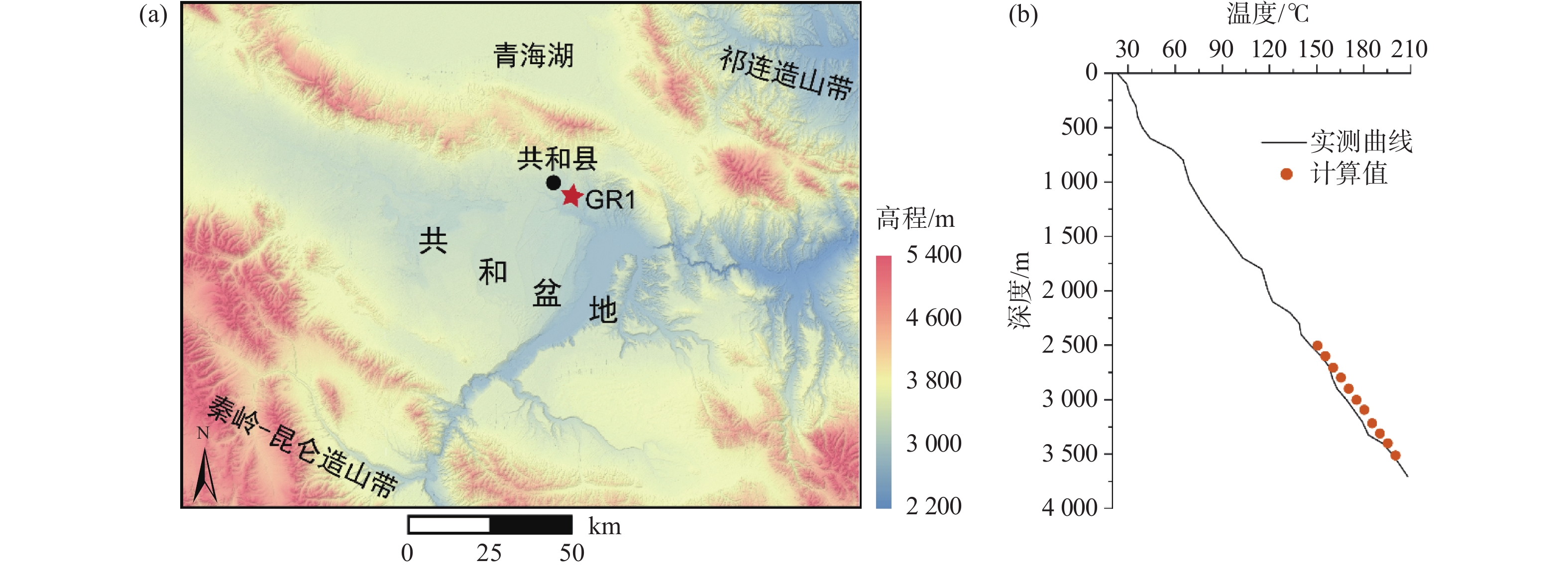
 下载:
下载:

